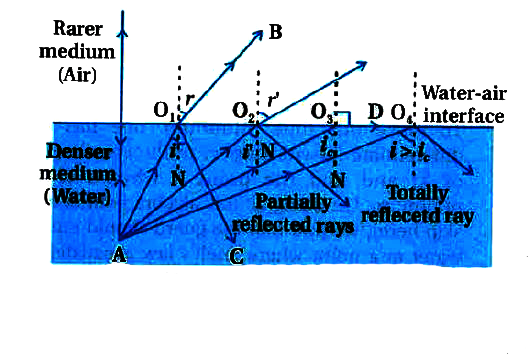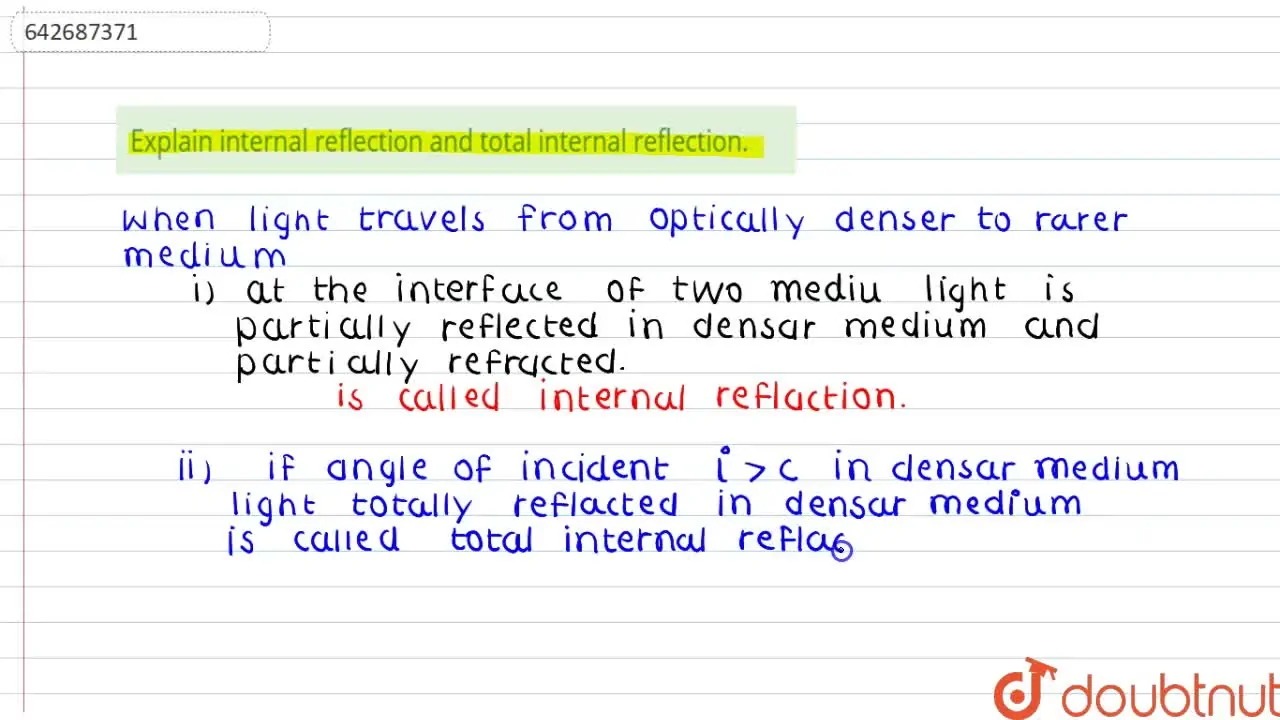Explain internal reflection and total internal reflection.Solution in Gujrati
When light travels from an optically denser medium to a rarer medium at the interface, it is partly reflected back into the same medium and partly refracted to the second medium. This reflection is called the internal reflection.
When a ray of light enters from a denser medium to a rarer medium it bends away from the normal.

The ray AO1B in figure the incident ray AO1, is partially reflected (O1C) and partially transmitted (O1B) or refracted.
The angle of refraction (r) being larger than the angle of incidence (i).
As the angle of incidence increases, so does the angle of refraction, till for the ray AO3, the angle of refraction is π2
The refracted ray is bent so much away from the normal that it grazes the surface at the interface between the two media. This is shown by the ray AO3D.
The angle of incidence for which the refraction angle becomes π2, that incidence angle is called critical angle .iC..
The deviated ray obtained after incidence at critical angle is called critical ray.
If the angle of incidence is increased still further e.g. the ray AO4, refraction is not possible and the incident ray is totally reflected. This is called total internal reflection,
When light gets reflected by a surface, normal some fraction of it gets transmitted. The reflected ray, therefore, is always less inten: than the incident ray, howsoever smooth th reflecting surface may be. In total intern reflection on the other hand, no transmission light takes place.
According to Snell.s law at point O3,
nisinic=n2sinr
∴n1n2sinic=sin r
∴n12sinic=sin90∘ [∵r=90∘]
∴n12sinic=1
∴12=1sinic (where n12 = refractive inde of denser medium-1 w.r.t. rarer medium-2)
If n1=n and n2 = 1 (air) then, sin ic = 1
∴n=1sinic
Related Playlists
- BOOK - KUMAR PRAKASHANCHAPTER - RAY OPTICS AND OPTICAL INSTRUMENTSEXERCISE - SECTION - A (TRY YOURSELF)74videos
RAY OPTICS AND OPTICAL INSTRUMENTS
- BOOK - KUMAR PRAKASHANCHAPTER - RAY OPTICS AND OPTICAL INSTRUMENTSEXERCISE - SECTION-B (NUMERICALS)(NUMERICAL FROM TEXTUAL ILLUSTRATIONS)17videos
RAY OPTICS AND OPTICAL INSTRUMENTS
- BOOK - KUMAR PRAKASHANCHAPTER - MOVING CHARGES AND MAGNETISMEXERCISE - SECTION D (MCQs ASKED IN COMPETITIVE EXAMS)34videos
MOVING CHARGES AND MAGNETISM
- BOOK - KUMAR PRAKASHANCHAPTER - SAMPLE QUESTION PAPER EXERCISE - PART-B SECTION-C5videos
SAMPLE QUESTION PAPER
Similar Questions
Give range of wavelength of visible light.
07:47View SolutionSuppose that the lower half of the concave mirror.s reflecting surface as shown in figure is covered with an opaque (non-reflective) material. What effect will this have on the image of an object placed in front of the mirror ?
 07:36View Solution
07:36View SolutionElectric charge Q having mass M moves on a circular path of radius R with velocity →v, perpendicular to uniform magnetic field B. When a particle completes one revolution, work done by the field is _______
02:56View SolutionTwo charges –q and +q are located at points (0, 0, –a) and (0, 0, a), respectively.
(a) What is the electrostatic potential at the points (0, 0, z) and (x, y, 0) ?
(b) Obtain the dependence of potential on the distance r of a point from the origin when r/a>>1 .
(c) How much work is done in moving a small test charge from the point (5,0,0) to (–7,0,0) along the x-axis? Does the answer change if the path of the test charge between the same points is not along the x-axis?04:01View SolutionConditions Of Total Internal Reflection
56:53View SolutionPartial reflection and Total internal reflection.
View SolutionExplain the phenomenon of total internal reflection.
01:53View SolutionWhat is total internal reflection of light ? What are conditions for total internal reflection ?
05:15View SolutionTotal Internal Reflection
42:23View SolutionTotal internal reflection
03:36View SolutionConditions Of Total Internal Reflection
04:35View SolutionExplain experiment which represents the total internal reflection.
02:48View SolutionTotal internal reflection
01:20View Solution(a) What is total internal reflection ?
(b) State two conditions necessary for total internal reflection to occur.
(c) draw diagrams to illustrate total internal reflection.View SolutionExplain total internal reflection from law of refraction.
View Solution


